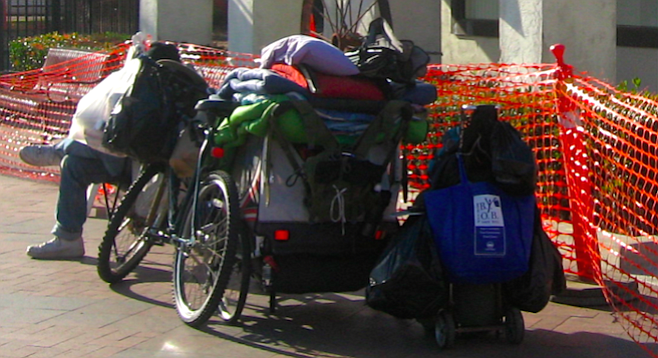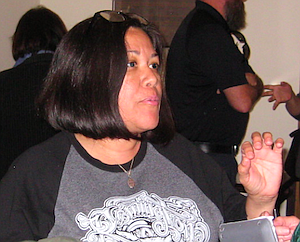 Facebook
Facebook
 X
X
 Instagram
Instagram
 TikTok
TikTok
 Youtube
Youtube

The agenda for the City of Chula Vista’s council meeting on March 8 was the homeless situation in the city. After innumerable multi-colored PowerPoints, a speaker from the audience said — “the city is in crisis.”
Lelani Hines, principal project coordinator, was the main presenter. According to Hines, the homeless population count in Chula Vista was 498 — 177 of those are sheltered, 103 live in vehicles, 35 in structures/tents, and the remaining 183 in streets, doorways, parks, or canyon encampments.
In 2015, the police had 3531 calls for service regarding homeless people or people complaining about homeless people; often the calls were related to people who suffer mental illness.
Of the 3531 calls for service, 626 resulted in crime reports; the highest number due to narcotic activity, followed by arrests or probation violation, violent crimes, burglary, or theft. The presenter pointed out some crimes were perpetrated on the homeless.
In collaboration with a single Chula Vista park ranger who services 57 parks, the primary police strategy appears to be sweeps. After communication with homeless individuals, the police sweep through the parks and seize property. The homeless then move out of the area. Police then sort the property and store materials like photos or other personal items they deem valuable and discard the rest.
As noted during the meeting, the sweeps have limited usefulness. Staff likened the sweeps to the “balloon effect”: when squeezed out of one area, homeless groups move to another.

Rosy Vasquez, the program manager for the Sister Dolores Social Outreach program located at Saint Rose of Lima, the only speaker from the audience, called Chula Vista’s homeless situation a crisis.
Vasquez said her program, “in 2015 served 412 unduplicated homeless individuals with emergency food and clothing and we served 4000 unduplicated residents facing food insecurity. I am here today to thank you on behalf of the individuals in Chula Vista who have found themselves without a proper home or residence due to unemployment, poor choices, mental or physical illness or evictions.”
Vasquez encouraged the council to fund an emergency shelter during the winter and appoint city staff to coordinate efforts.
In an interview, Vasquez said she finds it interesting that the city provides no housing for the homeless, but there are designated parking lots where families sleep in cars. “Saint Rose is open three times a week and 60 to 100 unduplicated individuals come in every time — not all of them would be called street people.”

Tino Martinez, a filmmaker and president of the Southwest Civic Association, is making a documentary about unsheltered people in Chula Vista. In a March 9 interview, Martinez said, “ I really want to put a human face on our homeless individuals; I don’t want people thinking they are taking over the parks. We need to share the parks.”
“A lot of our community commented on social media that they viewed the homeless as dangerous people and were saying the police need to take care of them, but we need to live together in the community. I’m a Christian man and I love to do the work of Jesus. My wife collects jackets for families. One thing on my prayer list is a mobile shower for the homeless.”
The day before the city report on the homeless situation, Martinez shot an interview with a homeless individual named Eddy who has lived in the area for over two years.
Eddy is a veteran. While Martinez was filming, Eddy got a call from a crisis center that found him a transitional home due to his veteran benefits. Martinez said, “I saw it in his face. He didn’t know what to do. He was afraid; he’d been out on the streets so long.
“I offered him a ride and storage for his things.” Eddy pondered this for 18 hours. The next day Martinez went and delivered Eddy to Division Street. “Once I dropped him off at this transitional home, I saw there were 4 or 5 bipolar people he would be living with. I asked him if he would be able to handle it. He said, 'Tino, I’ve lived with bipolar people in the park for years. This is nothing. I’ve got a roof over my head.'“
The city’s next step is to deepen the collaborations they have started and to seek more budget resources.


The agenda for the City of Chula Vista’s council meeting on March 8 was the homeless situation in the city. After innumerable multi-colored PowerPoints, a speaker from the audience said — “the city is in crisis.”
Lelani Hines, principal project coordinator, was the main presenter. According to Hines, the homeless population count in Chula Vista was 498 — 177 of those are sheltered, 103 live in vehicles, 35 in structures/tents, and the remaining 183 in streets, doorways, parks, or canyon encampments.
In 2015, the police had 3531 calls for service regarding homeless people or people complaining about homeless people; often the calls were related to people who suffer mental illness.
Of the 3531 calls for service, 626 resulted in crime reports; the highest number due to narcotic activity, followed by arrests or probation violation, violent crimes, burglary, or theft. The presenter pointed out some crimes were perpetrated on the homeless.
In collaboration with a single Chula Vista park ranger who services 57 parks, the primary police strategy appears to be sweeps. After communication with homeless individuals, the police sweep through the parks and seize property. The homeless then move out of the area. Police then sort the property and store materials like photos or other personal items they deem valuable and discard the rest.
As noted during the meeting, the sweeps have limited usefulness. Staff likened the sweeps to the “balloon effect”: when squeezed out of one area, homeless groups move to another.

Rosy Vasquez, the program manager for the Sister Dolores Social Outreach program located at Saint Rose of Lima, the only speaker from the audience, called Chula Vista’s homeless situation a crisis.
Vasquez said her program, “in 2015 served 412 unduplicated homeless individuals with emergency food and clothing and we served 4000 unduplicated residents facing food insecurity. I am here today to thank you on behalf of the individuals in Chula Vista who have found themselves without a proper home or residence due to unemployment, poor choices, mental or physical illness or evictions.”
Vasquez encouraged the council to fund an emergency shelter during the winter and appoint city staff to coordinate efforts.
In an interview, Vasquez said she finds it interesting that the city provides no housing for the homeless, but there are designated parking lots where families sleep in cars. “Saint Rose is open three times a week and 60 to 100 unduplicated individuals come in every time — not all of them would be called street people.”

Tino Martinez, a filmmaker and president of the Southwest Civic Association, is making a documentary about unsheltered people in Chula Vista. In a March 9 interview, Martinez said, “ I really want to put a human face on our homeless individuals; I don’t want people thinking they are taking over the parks. We need to share the parks.”
“A lot of our community commented on social media that they viewed the homeless as dangerous people and were saying the police need to take care of them, but we need to live together in the community. I’m a Christian man and I love to do the work of Jesus. My wife collects jackets for families. One thing on my prayer list is a mobile shower for the homeless.”
The day before the city report on the homeless situation, Martinez shot an interview with a homeless individual named Eddy who has lived in the area for over two years.
Eddy is a veteran. While Martinez was filming, Eddy got a call from a crisis center that found him a transitional home due to his veteran benefits. Martinez said, “I saw it in his face. He didn’t know what to do. He was afraid; he’d been out on the streets so long.
“I offered him a ride and storage for his things.” Eddy pondered this for 18 hours. The next day Martinez went and delivered Eddy to Division Street. “Once I dropped him off at this transitional home, I saw there were 4 or 5 bipolar people he would be living with. I asked him if he would be able to handle it. He said, 'Tino, I’ve lived with bipolar people in the park for years. This is nothing. I’ve got a roof over my head.'“
The city’s next step is to deepen the collaborations they have started and to seek more budget resources.
Comments